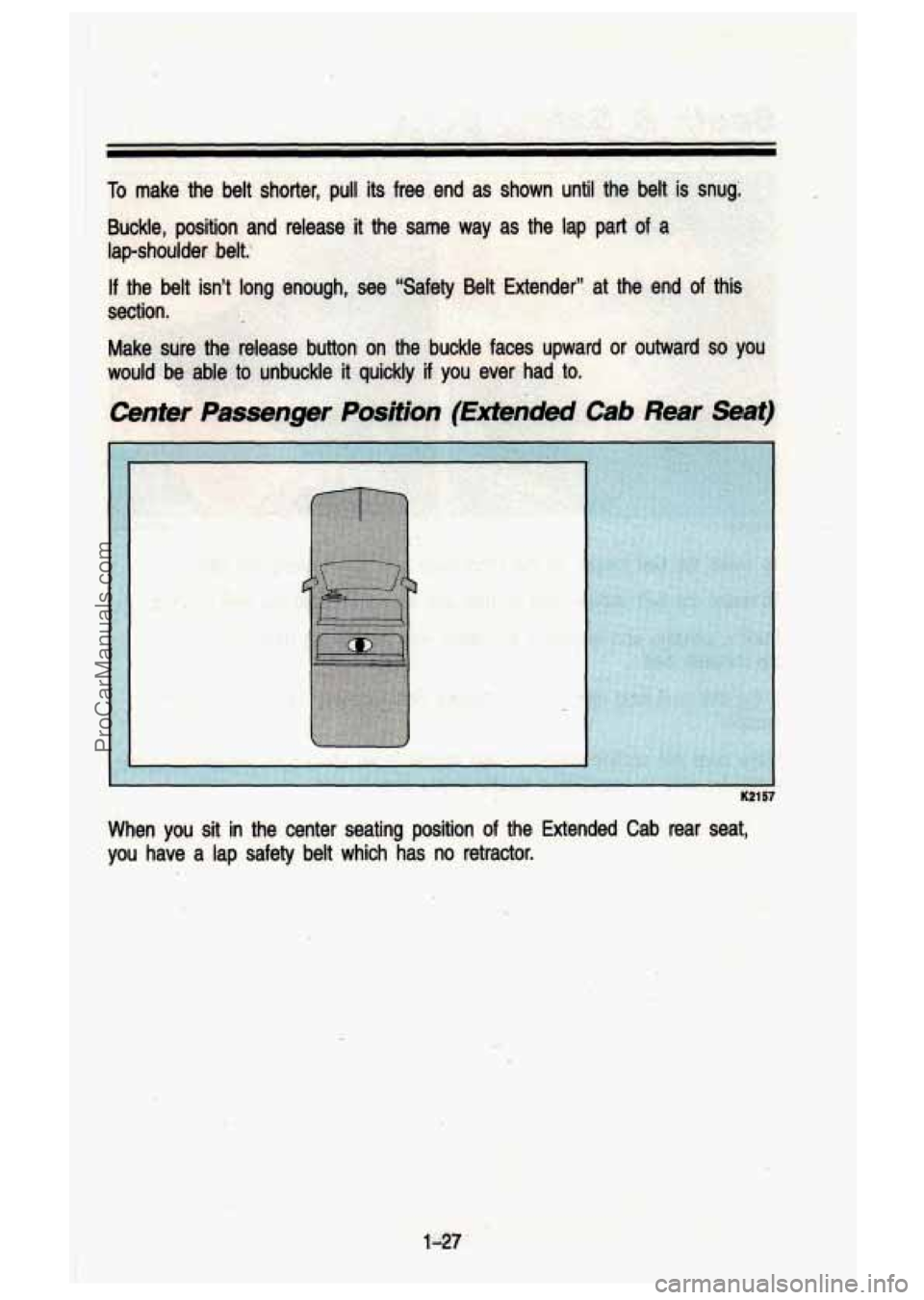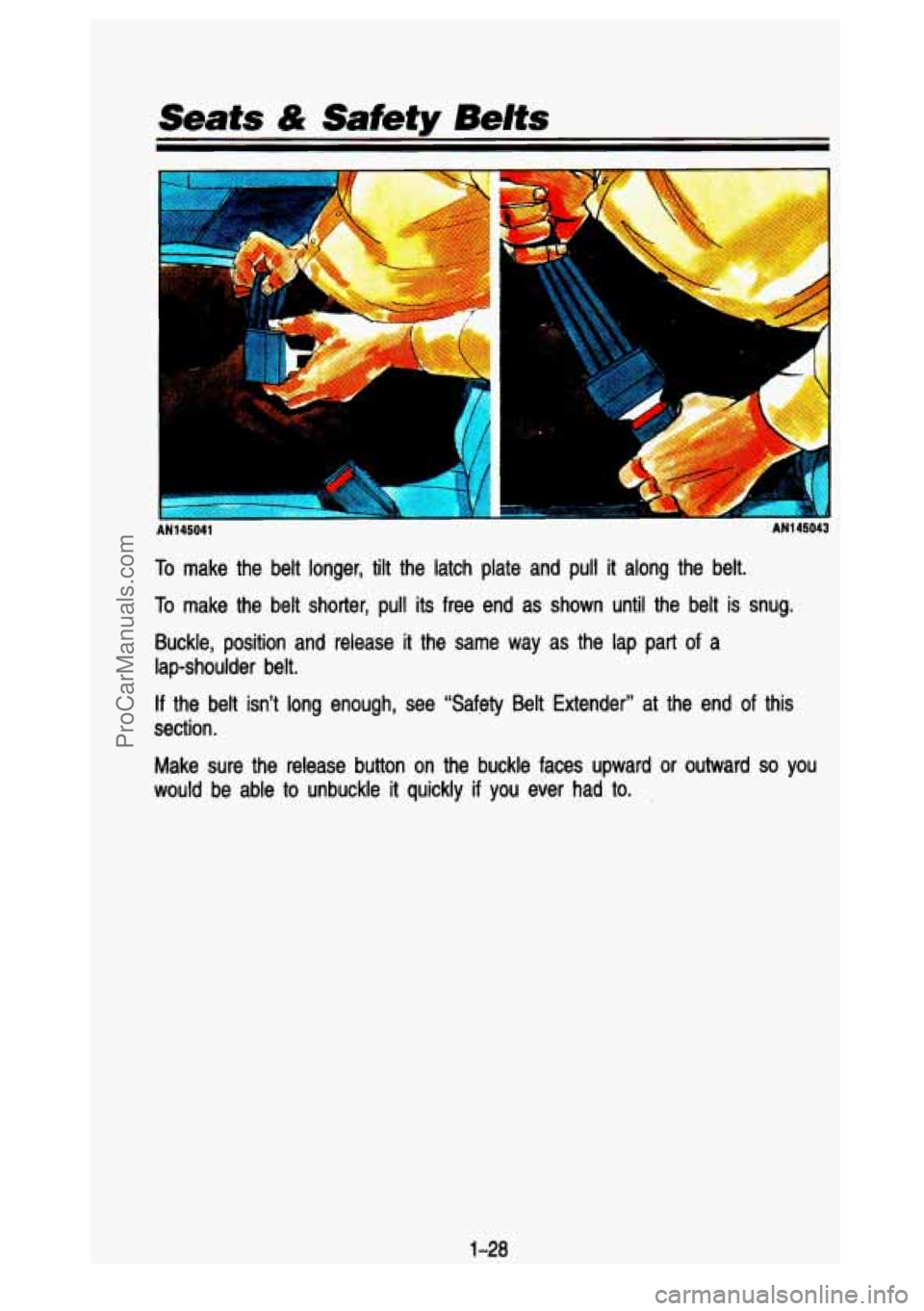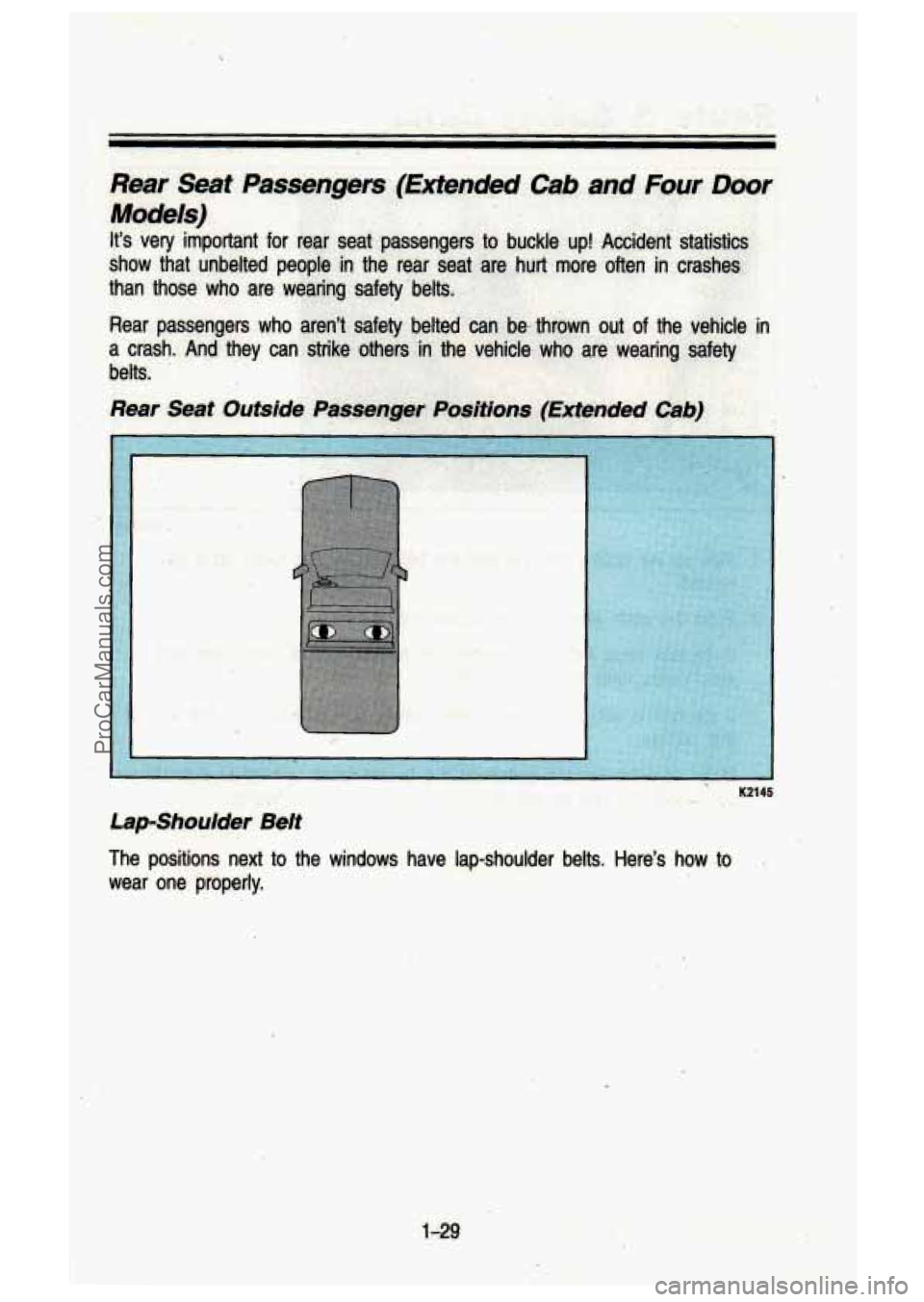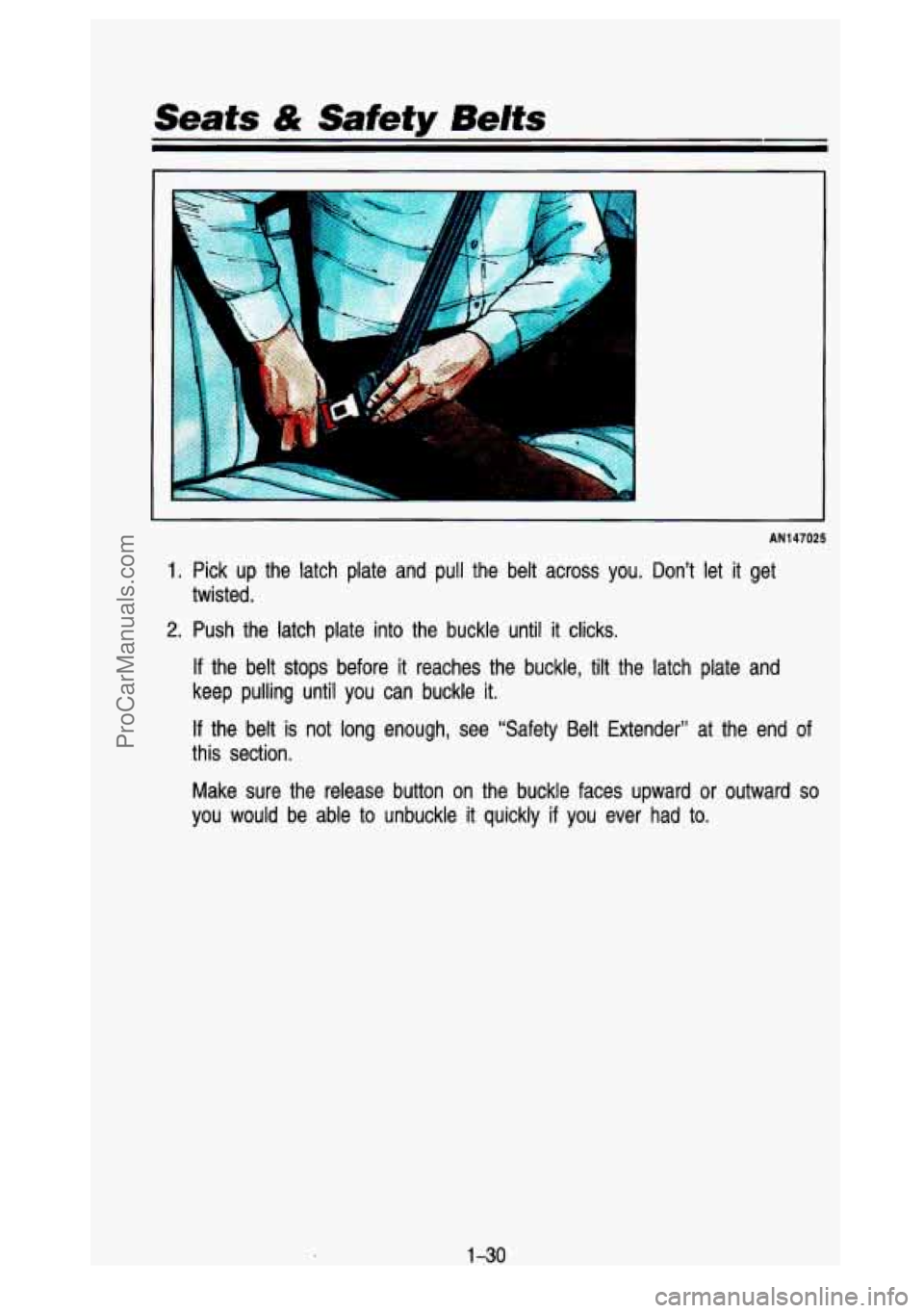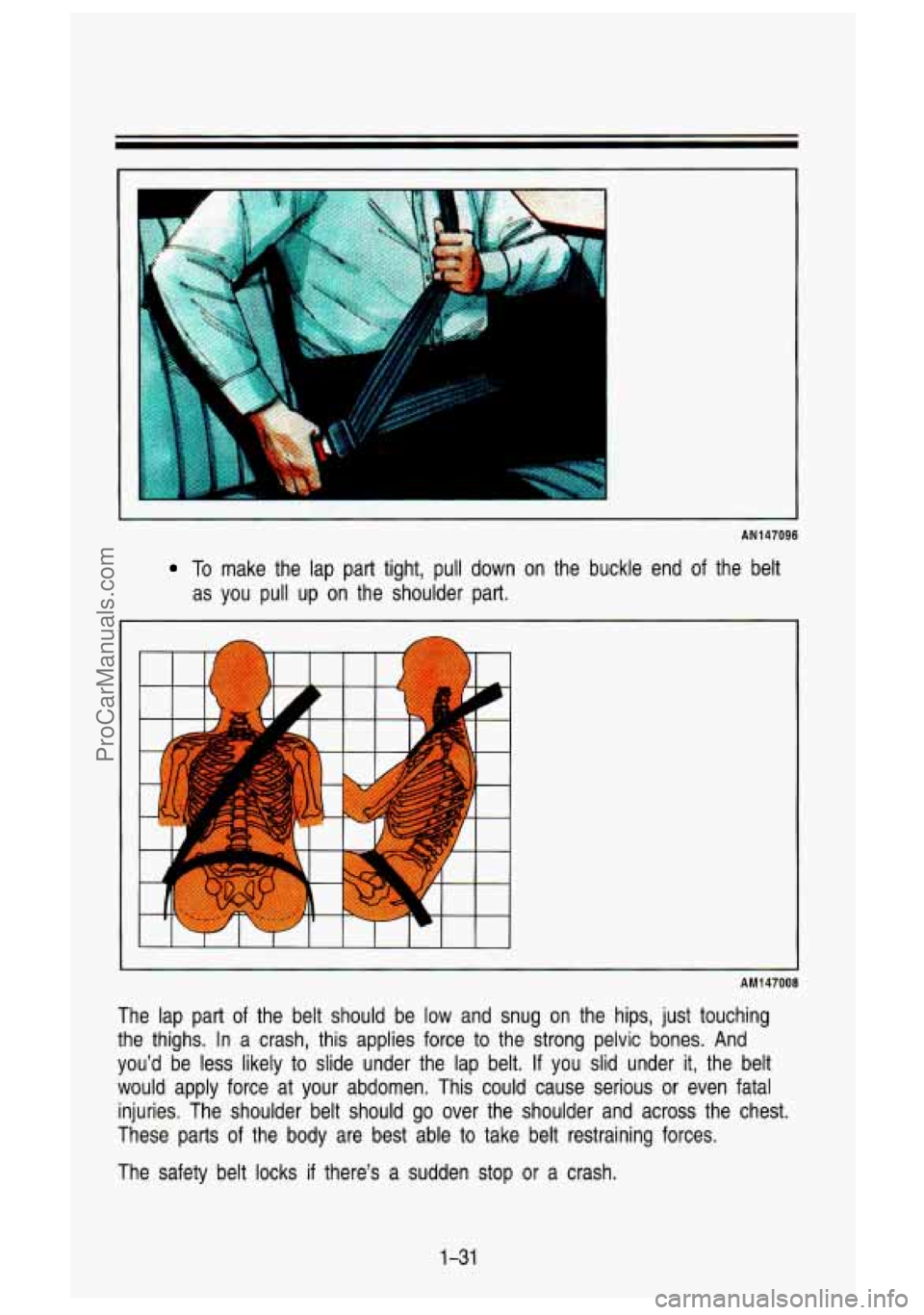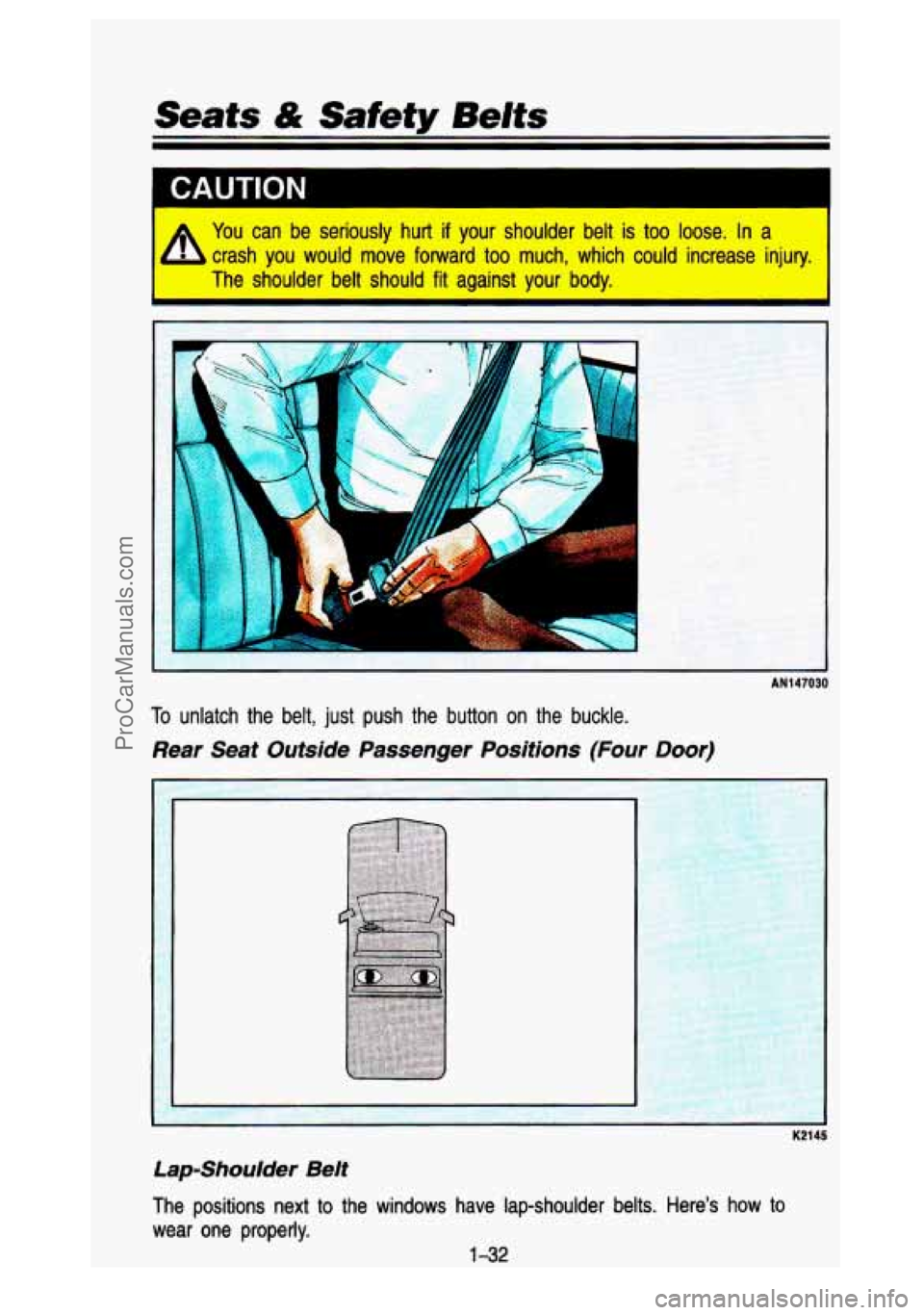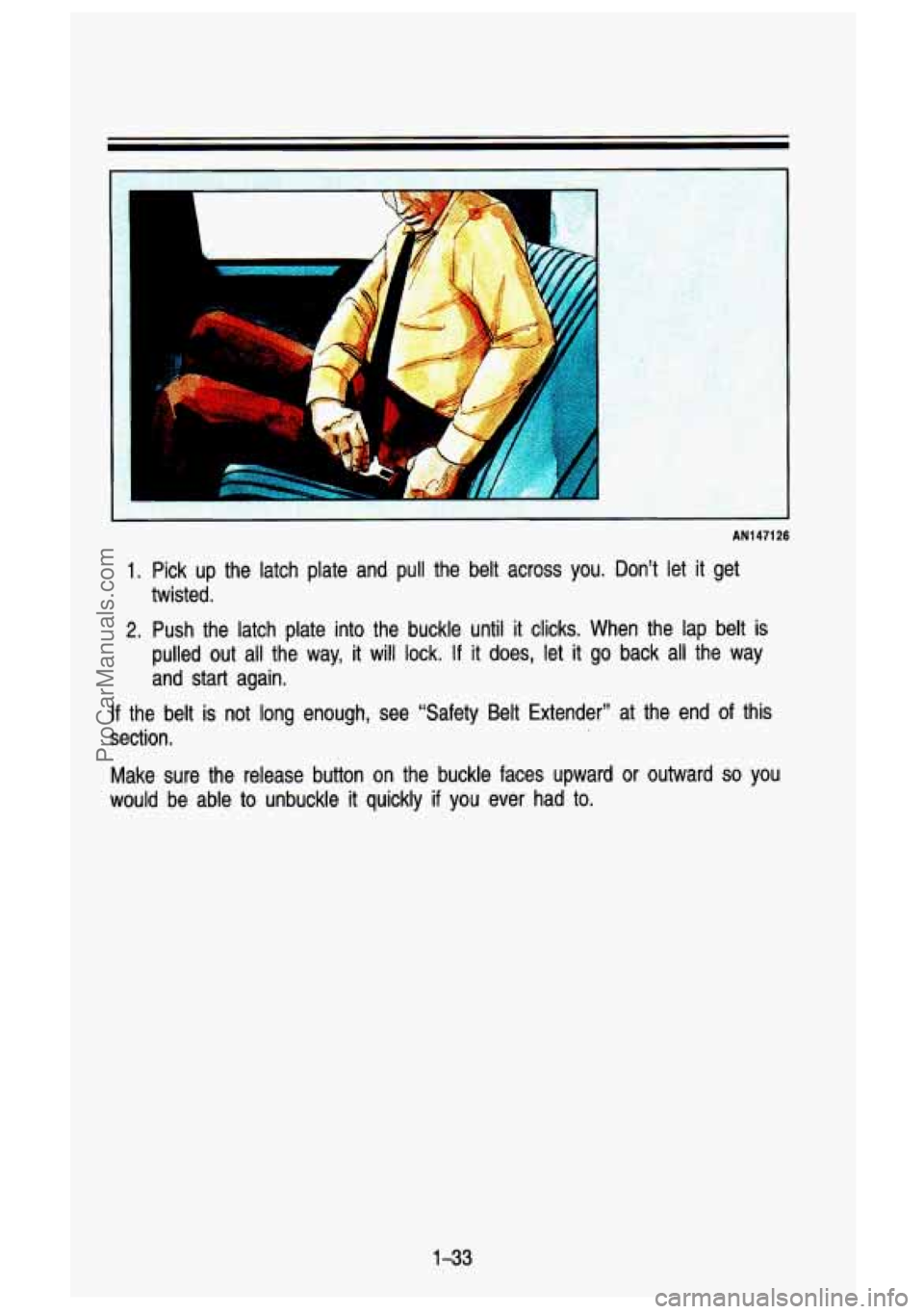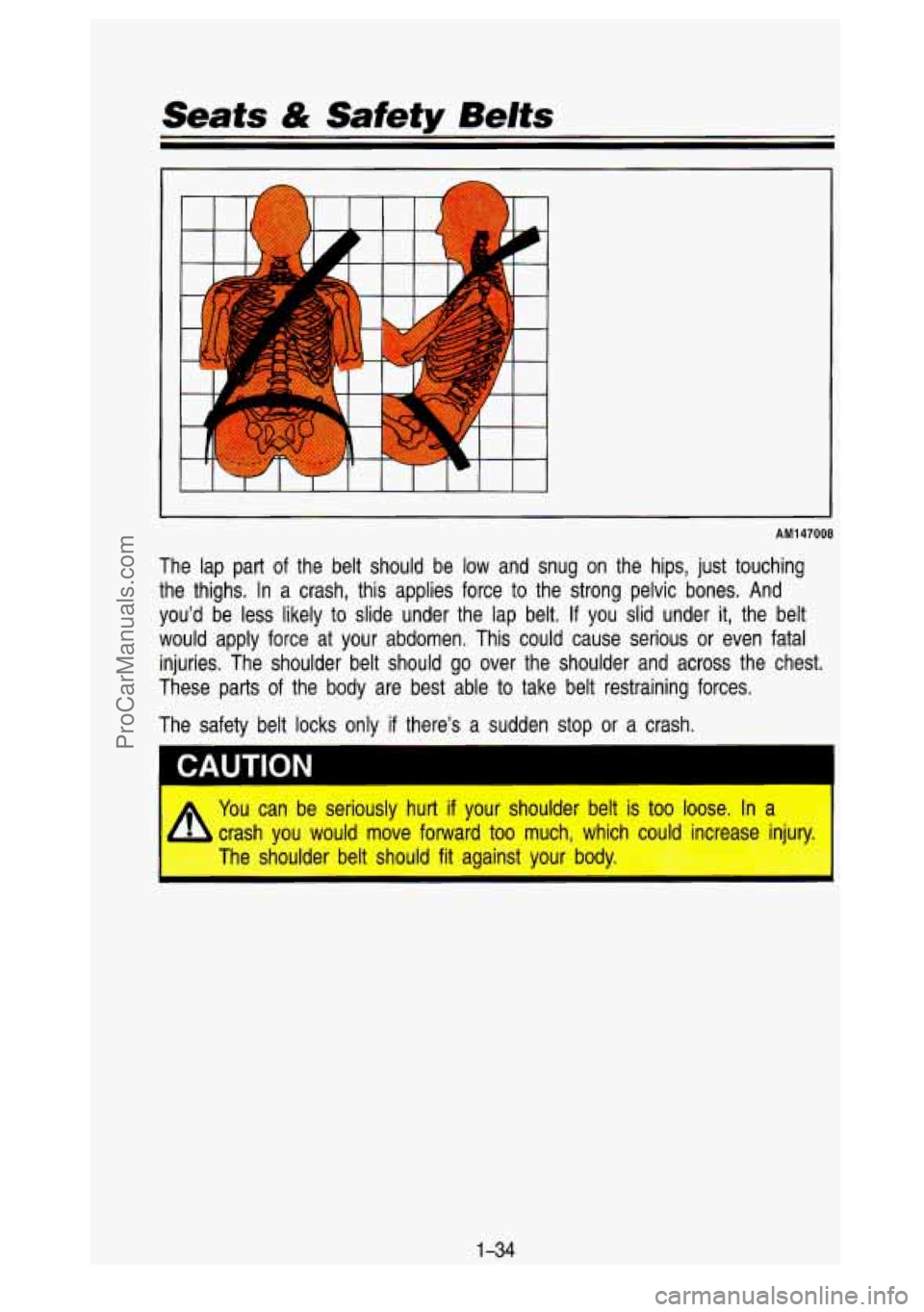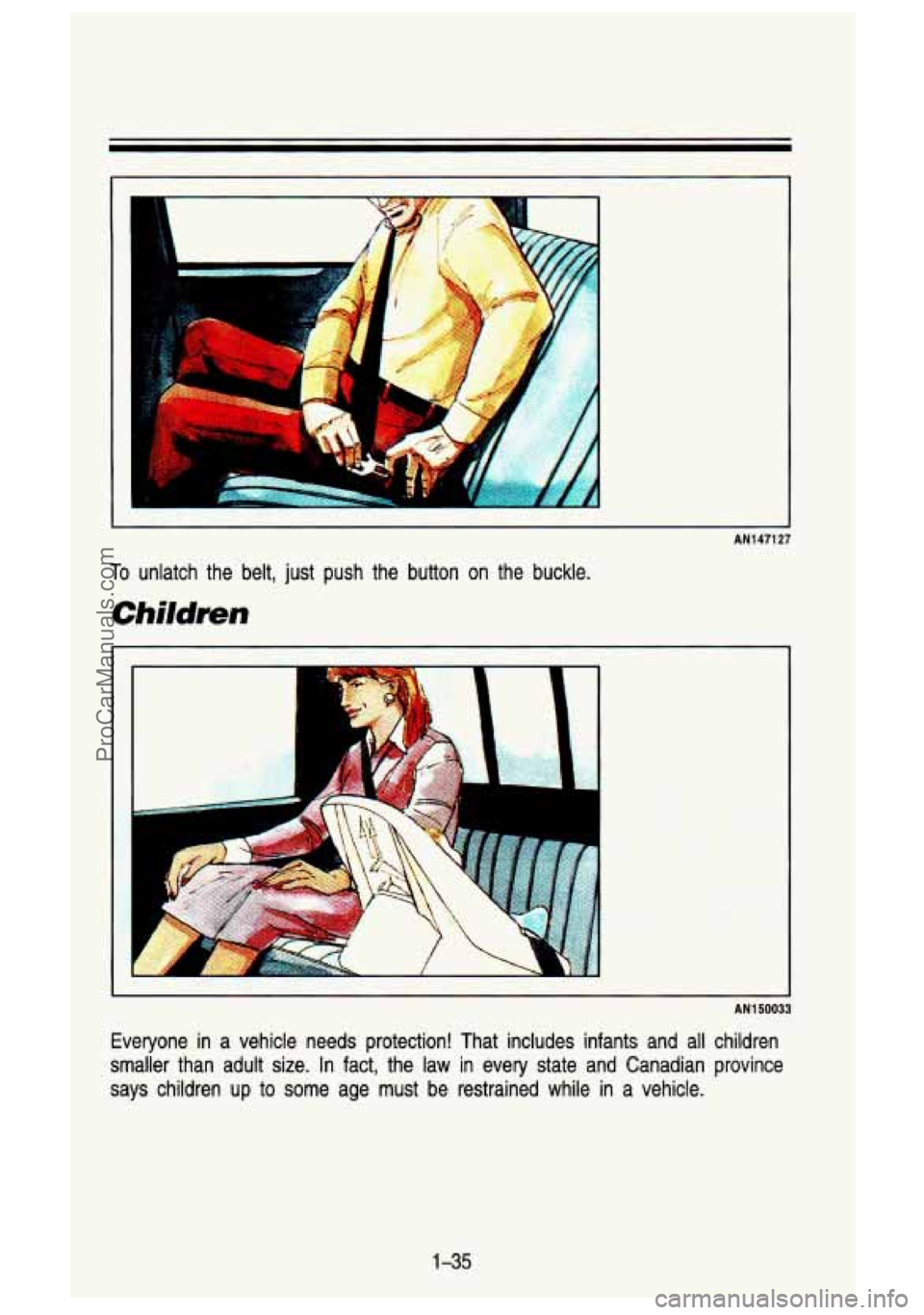GMC SIERRA 1993 Service Manual
Manufacturer: GMC, Model Year: 1993,
Model line: SIERRA,
Model: GMC SIERRA 1993
Pages: 436, PDF Size: 23.88 MB
GMC SIERRA 1993 Service Manual
SIERRA 1993
GMC
GMC
https://www.carmanualsonline.info/img/44/57859/w960_57859-0.png
GMC SIERRA 1993 Service Manual
Trending: horn, spare tire, reset, instrument cluster, engine, headlights, fold seats
Page 41 of 436
To make the belt shorter, pull its free end as shown until the belt is snug:
Buckle, position and release it the same way as the lap part of a
lap-shoulder belt.
If the belt isn't long enough, see "Safety Belt Extender" at the end of this
section.
Make sure the release button on the buckle faces upward or ou\
tward
so you
would be able to unbuckle it quickly
if you ever had to.
Center Passenger Position (Extended Cab Rear Seat)
ProCarManuals.com
Page 42 of 436
Seats & Safety Belts
-I
To make the belt longer, tilt the latch plate and pull it along the belt.
To make the belt shorter, pull its free end as shown until the \
belt is snug.
Buckle, position and release it the same way as the lap part of
a
lap-shoulder belt.
If the belt isn’t long enough, see “Safety Belt Extender” at the e\
nd of this
section.
Make sure the release button on the buckle faces upward
or outward so you
would be able to unbuckle
it quickly if you ever had to.
1-28
ProCarManuals.com
Page 43 of 436
.$ Rear Seat Passengers [Extended Cab and Four Door
1 Modek)
I It's very important for rear seat passengers to buckle up! Accident statistics'
I d show that nnbelted' people in the rear seat are hurt- more often in crashes
' -4 than those who are wearhg safety 'belts.. .- 7.w
I C Rear passengers who aren't safety belted can be. thrown out -of the vehicle in
w a crash. And they can stri'ke. others iri the vehicle who are wearing safety
8 -belts. bl
Rear Seat 0 Passenger Positions (Extended Cab)
I$
I ',
P '!
K2145
I
ProCarManuals.com
Page 44 of 436
Seafs & Safety Belts
i
AN147025
1. Pick up the latch plate and pull the belt across you, Don’\
t let it get
twisted.
2. Push the latch plate into the buckle until it clicks.
If the belt stops before it reaches the buckle, tilt the latch plate and
keep pulling until you can buckle it.
If the belt is not long enough, see “Safety Belt Extender” at the end of
this section.
Make sure the release button on the buckle faces upward or ou\
tward
so
you would be able to unbuckle it quickly if you ever had to.
1-30
ProCarManuals.com
Page 45 of 436
A
AN147096
To make the lap part tight, pull down on the buckle end of the belt
as you pull up on the shoulder part.
3
AM147008
The lap part of the belt should be low and snug on the hips, just touching
the thighs. In a crash, this applies force
to the strong pelvic bones. And
you’d be less likely to slide under the lap belt.
If you slid under it, the belt
would apply force at your abdomen. This could cause serious or\
even fatal injuries. The shoulder belt should go over the shoulder and across the chest.
These parts
of the body are best able to take belt restraining forces.
The safety belt locks
if there’s a sudden stop or a crash.
1-31
ProCarManuals.com
Page 46 of 436
Seats & Safety Belts
1 CAUTION
You can be seriously hurt if your shoulder belt is too loose. In a
crash you would move forward too much, which could increase injury.
The
shoulder belt should fit against your body. I
AN147030
To unlatch the belt, just push the button on the buckle.
Rear Seat Outside Passenger Positions (Four Door)
K2145
Lap-Shoulder Belt
The positions next to the windows have lap-shoulder belts. Here's how to
wear one properly.
1-32
ProCarManuals.com
Page 47 of 436
AN147126
1. Pick up the latch plate and pull the belt across you. Don’t let it get
twisted.
2. Push the latch plate into the buckle until it clicks. When the lap belt is
pulled out all the way, it will lock.
If it does, let it go back all the way
and start again.
If the belt is not long enough, see “Safety Belt Extender’’ at the\
end of this
section.
Make sure the release button on the buckle faces upward or ou\
tward
so you
would be able
to unbuckle it quickly if you ever had to.
1-33
ProCarManuals.com
Page 48 of 436
Seats & Safety Belts
AM147008
The lap part of the belt should be low and snug on the hips, just touching
the thighs. In a crash, this applies force to the strong pelv\
ic bones. And
you’d be less likely to slide under the lap belt. If
you slid under it, the belt
would apply force at your abdomen. This could cause serious or\
even fatal injuries. The shoulder belt should
go over the shoulder and across the chest.
These parts
of the body are best able to take belt restraining forces.
The safety belt locks only
if there’s a sudden stop or a crash.
You can be seriously hurt
if your shoulder belt is too loose. In a
crash you would move forward too much, which could increase i
The shoulder belt should fit against your body.
-
1-34
ProCarManuals.com
Page 49 of 436
AN1 471 27
To unlatch the belt, just push the button on the buckle.
Children
AN150033
Everyone in a vehicle needs protection! That includes infants and all children
smaller than adult size. In fact, the law in every state and Canadian province
says children up to some age must be restrained while in a vehicle.
1-35
ProCarManuals.com
Page 50 of 436
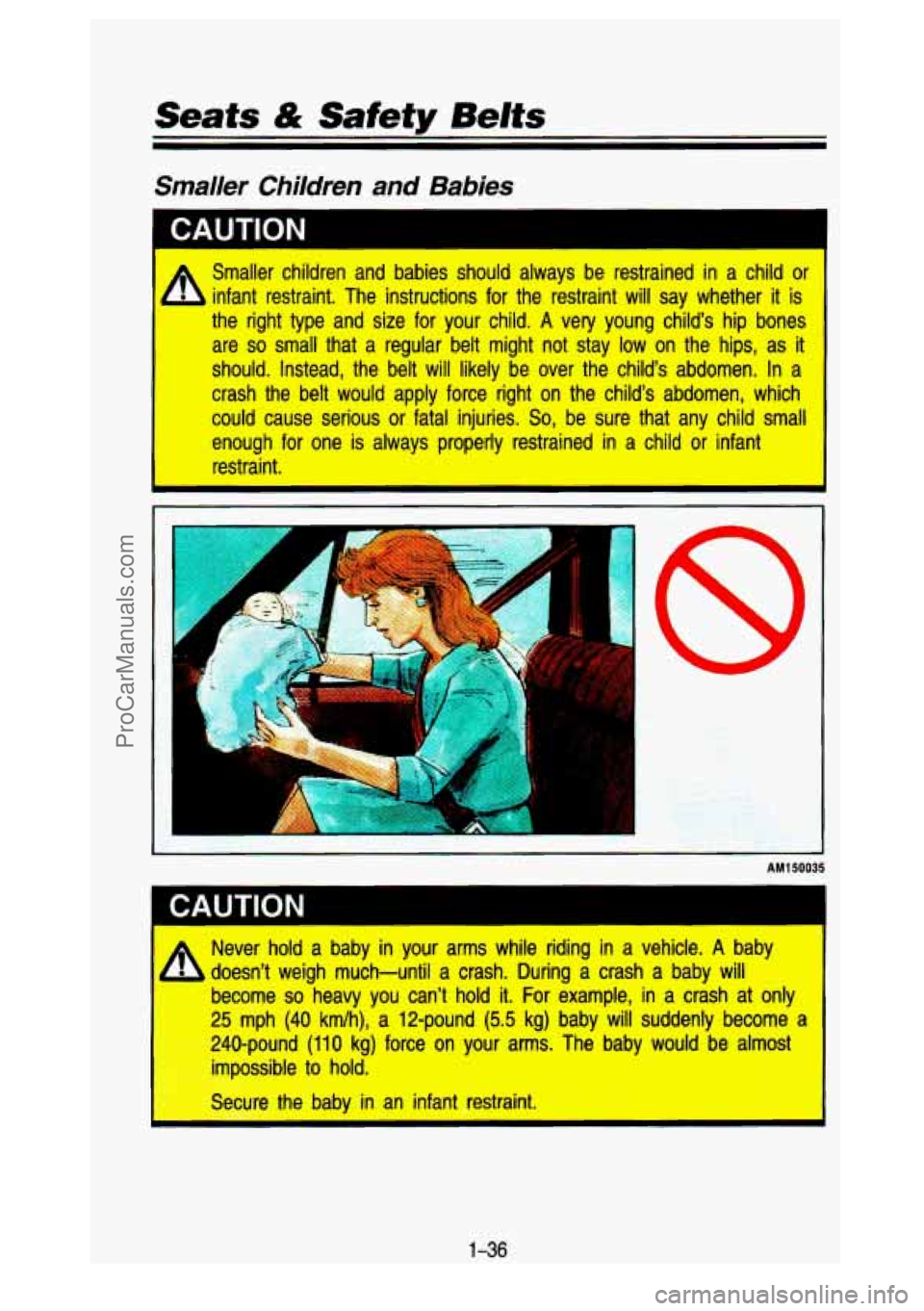
Seats & Safety Belts
Smaiier Children and Babies
I CAUTION
Smaller children and babies should always be restrained in a child or
infant restraint. The instructions for the restraint will say whether it is
the right type and size for your child.
A very young child’s hip bones
are so small that a regular belt might not stay low on the \
hips, as it
should. Instead, the belt will likely be over the child’s a\
bdomen. In a
crash the belt would apply force right on the child’s abdom\
en, which
could cause serious
or fatal injuries. So, be sure that any child small
enough for one is always properly restrained in a child
or infant
I restraint. I
AM150035
I CAUTION
Never hold a baby in your arms while riding in a vehicle. A baby
doesn’t weigh much-until a crash. During a crash a baby will
become
so heavy you can’t hold it. For example, in a crash at only
25 rnph (40 km/h), a 12-pound (5.5 kg) baby will suddenly become a
240-pound (11
0 kg) force on your arms. The baby would be almost
iec n an
ant restraint.
r . impossible to hold. .. .. - ’c- ., - ?, -I I.
1-36
ProCarManuals.com
Trending: tailgate, engine overheat, air suspension, oil type, radio controls, diagram, alternator belt
